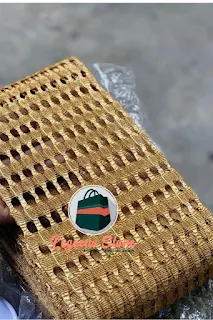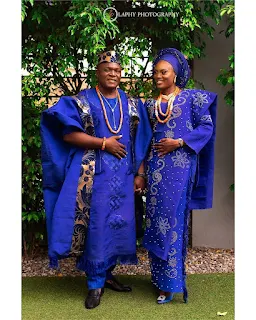Aso Oke or Aso ofi is a traditional fabric with great cultural significance in Yoruba society. It is a symbol of elegance, heritage, and pride. It is one of the numerous fabric common in Nigeria. In this article, we will explore the rich history, intricate designs, and versatile uses of Aso Oke, highlighting its importance in Yoruba and Nigerian fashion and celebrations.
Table of
Contents
Ø
Historical Significance of Aso Oke Fabric
Ø
Traditional Weaving Techniques
Ø
The Characteristics of Aso Oke
Ø
How much is aso oke in Nigeria?
Ø
Common Aso Oke designs in Contemporary times
Ø
Uses of Aso Oke in Nigerian Fashion
Ø Aso Oke in Yoruba Celebrations and Cultural Events
What is Aso Oke?
The term "Aso Oke," which when written in full is
"Aso Ilu Oke," is derived from the Yoruba language, with
"Aso" meaning cloth and "Oke" meaning borderland or afar;
therefore, Aso Oke means "cloth from a borderland or afar". It is a
traditional hand-woven fabric that has been a part of the Yoruba culture for
centuries. Aso Oke holds deep cultural significance and is often associated
with special occasions and celebrations.
While I was in primary school, we usually had a fashion parade wearing a beautiful lace buba, aso oke wrapper and gele to showcase the beauty of the African culture. The wrapper was usually short, commonly called "oleku," which was common in the Yoruba culture.
Historical Significance of Aso Oke Fabric
Aso Oke has a rich history that dates back to ancient times. It was originally worn by Yoruba royalty and nobility to symbolize status and wealth. Over the years, it has become more accessible to the general population. However, it still retains its aura of prestige and elegance. Aso oke is traditional for many Yoruba tribes, like the Akures, Ondos, Ijesha, and Ekiti People.
Common Fabrics in Nigerian Market
Traditional Weaving Techniques
The production of Aso Oke involves intricate weaving techniques passed down through generations. The fabric is typically woven on a narrow loom using a combination of cotton and silk threads. Skilled artisans meticulously create elaborate patterns and motifs, showcasing their expertise and artistry. Weaving the aso oke requires skilfulness and patience; however, technology has been employed to make intricate and beautiful fabric designs to ensure the process is easier. Still, many prefer the traditionally woven fabric because of its quality and feel.
The Characteristics of Aso Oke
- Fabric Composition and
Texture
Aso Oke is known for its unique composition, combining cotton and silk threads. This blend results in a fabric that is both sturdy and luxurious. The texture of Aso Oke can vary depending on the weaving technique used, but it often has a slightly rough yet soft feel. There are various types of aso oke in the market, making it appealing.
- Patterns and Designs
One of the distinguishing features of Aso Oke is its intricate patterns and designs. These patterns can range from geometric shapes to stylized motifs inspired by nature, culture, or historical events. Each pattern has a symbolic meaning, making Aso Oke a visual storytelling medium. Recently, laser machines have been introduced to create exquisite designs and edges to make the fabric elegant and fit the modern era.
- Colour Symbolism
Colours play a significant role in Aso Oke, with each shade representing different meanings. For example, blue symbolizes love and peace, while gold represents wealth and prosperity. The choice of colours in Aso Oke is often influenced by the occasion or the wearer's preference. For weddings and events, the colour and designs depend on the host's preference.
How much is Aso Oke in Nigeria?
The price of Aso Oke varies depending on
the material, quality and length of the Aso Oke. A full pack of aso oke
contains eight strands; 3 strands are sewn together for the "gele"
(Head tie), 4 for the "ipele" (meaning shoulder cloth) and one strand
is sewn for the "Fila" (cap).
Common Aso Oke designs in Contemporary times
- Silk aso oke
- Cotton Aso oke
- Metallic
or Two tone Aso oke
Uses of Aso Oke in Nigerian Fashion
- As Traditional Attire
Aso Oke is commonly used in traditional Nigerian attire,
especially for special occasions like weddings, naming ceremonies, and cultural
festivals. It is often worn as wrappers, head ties, caps, and accessories. The
vibrant colours and intricate designs of Aso Oke enhance the beauty and
regality of traditional outfits.
You May Also like
30 Elegant and Gorgeous Traditional Wedding Attire
- Modern
Fashion Trends
In recent years, Aso Oke has also gained popularity in
contemporary fashion. Designers incorporate Aso Oke into modern clothing
styles, such as dresses, skirts, blouses, and suits. This fusion of traditional
fabric with modern fashion showcases the versatility and timelessness of Aso
Oke.
- Aso
Oke Accessories
Aso Oke is not limited to clothing alone. It is also used to
create beautiful accessories like handbags, shoes, jewellery, and home decor
items. These accessories serve as statement pieces, adding a touch of Nigerian
cultural heritage to any ensemble or living space.
Aso Oke in Yoruba Celebrations and Cultural Events
The fabric is common in Yoruba celebrations and events. Some
of the occasions where it is used include;
Aso Oke is an integral part of Nigerian weddings. The bride, groom, and their families often wear matching Aso Oke outfits to signify unity and celebrate the joyous occasion. Many times the groom wears an "agbada" and "sokoto" while the bride wears a "buba" and "iro" (blouse and wrapper). In modern times, brides wear their aso oke as gowns, depending on the bride's choice. Aso Oke is also used as decorations in wedding venues, adding elegance and cultural flair to the celebration.
Aso Oke in Festivals and
Ceremonies
Nigerian festivals and cultural ceremonies are incomplete
without Aso Oke. Participants and attendees adorn themselves in Aso Oke
garments, showcasing their cultural heritage and pride. Aso Oke adds a sense of
grandeur and tradition to these events.
Aso Oke as a Cultural
Heritage
Aso Oke is not just a fabric; it represents Nigeria's
cultural heritage. It is a tangible link to the country's history, traditions,
and artistic skills. Preserving and promoting the art of Aso Oke weaving is
essential to ensure its continuity for future generations.
Finally, Aso Oke is a fabric that embodies Nigeria's beauty,
tradition, and cultural richness. From its historical significance to its
intricate designs, Aso Oke is special in Yoruba fashion, history and
celebrations. Whether worn for traditional events or incorporated into contemporary
fashion, Aso Oke continues to captivate and inspire fashion lovers with its
timeless elegance. Embracing Aso Oke means embracing Nigerian culture and
heritage, celebrating the craftsmanship of skilled artisans, and carrying
forward a cherished tradition for generations to come. We at Legeens Store are
committed to making your day beautiful by sourcing the best aso oke for you.




